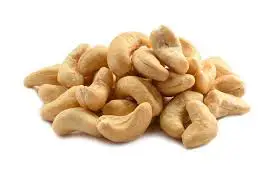The Top 5 Cashew Nut Producing Countries
| Country | Cashew Production (metric tonnes) |
% of World Total | |
|---|---|---|---|
| 1 | Viet Nam | 2,663,885 | 44.9% |
| 2 | India | 785,925 | 13.2% |
| 3 | Côte d'Ivoire | 688,000 | 11.5% |
| 4 | Philippines | 228612 | 3.8% |
| 5 | Benin | 215,232 | 3.6% |
 Special Report
Special Report
The Mighty Cashew
The Cashew is a nut-bearing tree that is native to the country of Brazil. Noticing that it's many roots grew wide and deep, and was an effective tree to prevent erosion in sandy or rocky soil, some very observant Portuguese scooped up a few cashew trees sometime around the 15th century and shipped them off to India and West Africa. Eventually, someone decided that the cashew kernel would be extremely tasty all fried up in oil, making them nutty and crunchy, and then they sprinkled some salt on them and the rest is snack history.
Cashews are Pretty Darn Nutritious
The Cashew is a nice little packet of nutrition disguised as a nut. It is around 46% fat - most of it monounsaturated (60%) and polyunsaturated (20%), cashew is 25% carbohydrates and contains a lot of protein at 21%. One ounce of cashews contains about 160 calories. Cashews are also high in minerals like copper with 31% of the daily value per ounce (28 grams) and Manganese with 23% of the daily value (copper and manganese are important minerals for bone health). Cashews are also a good source of vitamin K at 12% of the daily intake. Vitamin K helps in regulating blood calcium levels. Cashews are also rich in antioxidants. If you eat a lot of cashews though, you may want to eat them unsalted, to avoid getting too much salt in your diet.
Global Cashew Production
The Cashew is a major product for millions of small-scale farmers around the globe. Worldwide the annual production is about 6 million tons of raw nuts (RCN) with an estimated value of US$ 6.5 - 7 billion. The current main cashew production regions are Africa, India, Vietnam and the Philippines. Cashew nuts consist of 35-45% seeds and around 55-65% of shells. The shells contain 15-30% oil. A ton of nuts contains around 200 kg seeds and 180 kg oil (cashew nut oil or cashew nut shell liquid “CNSL“). CNSL is used as oil for industrial purposes. Between 60% to 80% of cashew kernels produced are consumed as a roasted, salty snack. The main markets are the USA, the European Union, Japan and the Republic of Korea. 34% of the global demand for cashew kernels comes from India followed by North America at 24% and the EU at 17%.
Côte d'Ivoire is the world's largest exporter of cashews (in the shell) at 654,327 metric tonnes exported in 2018, followed by Ghana and the United Republic of Tanzania. The country that imports the most cashews are India at 871,163 metric tonnes in 2018. Vietnam is the next largest importer of cashews followed by China. The United States imports 152,500 metric tonnes of cashews (shelled) per year.
Cashews: Yummy But Expensive
Cashew kernels are ranked as either the second or third most expensive nut traded in the United States. Only macadamia nuts are priced higher and pecan nuts can be more expensive than either Macadamia nuts or cashews if the harvest is poor. Cashew nuts have a well-established market in the United States with a great variety of uses. Retail prices range from about $4-11 per pound to $9-23 per kg (USD), depending on the size of the nut and the packaging. The retail margins for Cashews is around 30%
Cashews Have Many Uses
Three main cashew products are traded on the international market: 1. the raw nuts, 2. the cashew kernels and 3. the cashew nut shell liquid (CNSL), which is extensively used for industrial purposes. A fourth product - the cashew apple is generally processed and consumed locally.
Cashews Grow on Trees?
As a matter of fact, yes, cashews do indeed grow on trees. The cashew tree, native to Brazil, was introduced to Mozambique and then India in the sixteenth century by the Portuguese, as a means of controlling coastal erosion. It was spread within these countries with the aid of elephants that ate the bright cashew fruit along with the attached nut. The nut was too hard to digest and was later expelled with the droppings. It was not until the nineteenth century that plantations were developed and the tree then spread to several other countries in Africa, Asia and Latin America.
The cashew is a close relative of mangoes, pistachios, poison ivy and poison oak. Most cashew trees start bearing fruit in the third or fourth year and are likely to reach their mature yield by the seventh year if conditions are favourable. The average yield of nuts of a mature tree is in the range of 7-11 kg per annum. Although the cashew tree is capable of living for 50-60 years, most trees produce nuts for about 15-20 years. The harvesting and processing of cashew is very labour intensive.
Top 5 Special Reports sources::
- Food and Agriculture Organization of the United Nations (2016). Retrieved Jun 27, 2018. www.fao.org
- International Finance Corporation European Union. (2010). "Prospects for Cambodia’s Cashew Sub-sector". Retrieved 2020.
Sources: FAOSTAT data, 2020 (Latest available data accessed by Top5ofAnything.com: July 10th, 2020).
List Notes: Cashew production is in metric tonnes for the year 2018 which is the latest available data as of July 10th, 2020. Please note: this cashew production data includes the shell.

